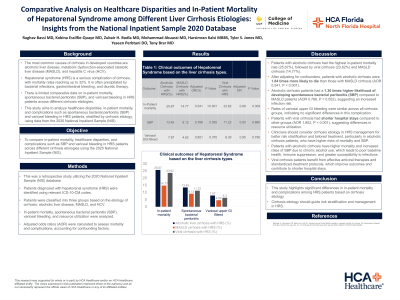Monday Poster Session
Category: Liver
P2946 - Comparative Analysis on the Healthcare Disparities and Inpatient Mortality of Hepatorenal Syndrome Among Different Liver Cirrhosis Etiologies: Insights From the National Inpatient Sample
Monday, October 28, 2024
10:30 AM - 4:00 PM ET
Location: Exhibit Hall E

Has Audio

Raghav Bassi, MD
University of Central Florida College of Medicine
Gainesville, FL
Presenting Author(s)
Raghav Bassi, MD1, Zubair H.. Bodla, MD1, Mohammad Abuassi, MD1, Harsimran Kalsi, MBBS1, Kobina Essilfie-Quaye, MD1, Radhika Bassi, BSc2, Yaseen Perbtani, DO1, Tony S.. Brar, MD1
1University of Central Florida College of Medicine, Gainesville, FL; 2Ross University School of Medicine, Chicago, IL
Introduction: The three most common causes of cirrhosis in the developed world are alcoholic liver disease, metabolic dysfunction-associated steatotic liver disease (MASLD), and hepatitis C virus (HCV). One of the feared complications of cirrhosis is the development of hepatorenal syndrome (HRS) with mortality rates reaching 32%. Common precipitating factors include bacterial infections, gastrointestinal bleeding, and diuretic therapy. Throughout literature, there is limited data on the mortality rates when looking at the different etiologies of liver cirrhosis in patients diagnosed with HRS.
Methods: Retrospective analysis using the 2020 National Inpatient Sample dataset, and utilizing relevant ICD-10-CM codes to calculate the adjusted odds ratio (AOR). We identified patients who were admitted with HRS and then classified them into different cohorts based on the underlying etiology of their cirrhosis.
Results: A total of 29,760 patients admitted with HRS were evaluated. 22,345 had underlying alcoholic cirrhosis, 4,875 had MASLD cirrhosis and 2,540 had HCV cirrhosis. The average ages for alcoholic, MASLD, and HCV cirrhosis mediated HRS were 53.64, 64.92, and 60.98 years respectively. Patients who developed HRS with underlying alcoholic cirrhosis had an in-patient all-cause mortality rate of 25.67%. In comparison, the mortality rate was 14.77% for MASLD cirrhosis and 23.62% for viral cirrhosis. After adjusting for confounders, MASLD cirrhosis patients had a decreased odds of in-patient mortality compared to the alcoholic cirrhosis group (AOR 0.541, P < 0.001) (Table 1). When analyzing rates of spontaneous bacterial peritonitis (SBP), alcoholic cirrhosis patients had a 1.30 times increased likelihood of developing SBP compared to MASLD patients (AOR 0.768, P=0.052). Rates of variceal upper GI bleed rates were statistically similar between all three groups. Regarding resource utilization, viral cirrhosis patients had a significantly shorter hospital stay (AOR 1.802, P < 0.001).
Discussion: Patients with alcoholic cirrhosis-mediated HRS were 1.84 times more likely to die than MASLD cirrhosis. Furthermore, patients with alcoholic cirrhosis were also more likely to develop SBP which approached statistical significance, putting them at an increased risk of HRS. It is important for clinicians to be aware of the underlying etiology of cirrhosis when managing patients with HRS to help with risk-stratification and to help initiate prompt treatment.
Note: The table for this abstract can be viewed in the ePoster Gallery section of the ACG 2024 ePoster Site or in The American Journal of Gastroenterology's abstract supplement issue, both of which will be available starting October 27, 2024.
Disclosures:
Raghav Bassi, MD1, Zubair H.. Bodla, MD1, Mohammad Abuassi, MD1, Harsimran Kalsi, MBBS1, Kobina Essilfie-Quaye, MD1, Radhika Bassi, BSc2, Yaseen Perbtani, DO1, Tony S.. Brar, MD1. P2946 - Comparative Analysis on the Healthcare Disparities and Inpatient Mortality of Hepatorenal Syndrome Among Different Liver Cirrhosis Etiologies: Insights From the National Inpatient Sample, ACG 2024 Annual Scientific Meeting Abstracts. Philadelphia, PA: American College of Gastroenterology.
1University of Central Florida College of Medicine, Gainesville, FL; 2Ross University School of Medicine, Chicago, IL
Introduction: The three most common causes of cirrhosis in the developed world are alcoholic liver disease, metabolic dysfunction-associated steatotic liver disease (MASLD), and hepatitis C virus (HCV). One of the feared complications of cirrhosis is the development of hepatorenal syndrome (HRS) with mortality rates reaching 32%. Common precipitating factors include bacterial infections, gastrointestinal bleeding, and diuretic therapy. Throughout literature, there is limited data on the mortality rates when looking at the different etiologies of liver cirrhosis in patients diagnosed with HRS.
Methods: Retrospective analysis using the 2020 National Inpatient Sample dataset, and utilizing relevant ICD-10-CM codes to calculate the adjusted odds ratio (AOR). We identified patients who were admitted with HRS and then classified them into different cohorts based on the underlying etiology of their cirrhosis.
Results: A total of 29,760 patients admitted with HRS were evaluated. 22,345 had underlying alcoholic cirrhosis, 4,875 had MASLD cirrhosis and 2,540 had HCV cirrhosis. The average ages for alcoholic, MASLD, and HCV cirrhosis mediated HRS were 53.64, 64.92, and 60.98 years respectively. Patients who developed HRS with underlying alcoholic cirrhosis had an in-patient all-cause mortality rate of 25.67%. In comparison, the mortality rate was 14.77% for MASLD cirrhosis and 23.62% for viral cirrhosis. After adjusting for confounders, MASLD cirrhosis patients had a decreased odds of in-patient mortality compared to the alcoholic cirrhosis group (AOR 0.541, P < 0.001) (Table 1). When analyzing rates of spontaneous bacterial peritonitis (SBP), alcoholic cirrhosis patients had a 1.30 times increased likelihood of developing SBP compared to MASLD patients (AOR 0.768, P=0.052). Rates of variceal upper GI bleed rates were statistically similar between all three groups. Regarding resource utilization, viral cirrhosis patients had a significantly shorter hospital stay (AOR 1.802, P < 0.001).
Discussion: Patients with alcoholic cirrhosis-mediated HRS were 1.84 times more likely to die than MASLD cirrhosis. Furthermore, patients with alcoholic cirrhosis were also more likely to develop SBP which approached statistical significance, putting them at an increased risk of HRS. It is important for clinicians to be aware of the underlying etiology of cirrhosis when managing patients with HRS to help with risk-stratification and to help initiate prompt treatment.
Note: The table for this abstract can be viewed in the ePoster Gallery section of the ACG 2024 ePoster Site or in The American Journal of Gastroenterology's abstract supplement issue, both of which will be available starting October 27, 2024.
Disclosures:
Raghav Bassi indicated no relevant financial relationships.
Zubair Bodla indicated no relevant financial relationships.
Mohammad Abuassi indicated no relevant financial relationships.
Harsimran Kalsi indicated no relevant financial relationships.
Kobina Essilfie-Quaye indicated no relevant financial relationships.
Radhika Bassi indicated no relevant financial relationships.
Yaseen Perbtani indicated no relevant financial relationships.
Tony Brar indicated no relevant financial relationships.
Raghav Bassi, MD1, Zubair H.. Bodla, MD1, Mohammad Abuassi, MD1, Harsimran Kalsi, MBBS1, Kobina Essilfie-Quaye, MD1, Radhika Bassi, BSc2, Yaseen Perbtani, DO1, Tony S.. Brar, MD1. P2946 - Comparative Analysis on the Healthcare Disparities and Inpatient Mortality of Hepatorenal Syndrome Among Different Liver Cirrhosis Etiologies: Insights From the National Inpatient Sample, ACG 2024 Annual Scientific Meeting Abstracts. Philadelphia, PA: American College of Gastroenterology.

